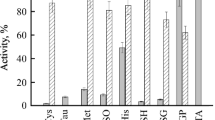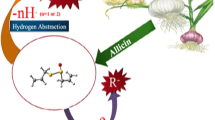Abstract
Prooxidant properties of aminophenol, the constituent of acetaminophen and mesalamine, were examined. Aminophenol compounds/copper-dependent formation of reactive oxygen species was analyzed by the inactivation of aconitase, the most sensitive enzyme to oxidative stress in permeabilized yeast cells. Aminophenol compounds of 2 (ortho)- and 4 (para)- substituents, but not 3 (meta)-isomer produced reactive oxygen species in the presence of copper (cupric) ion or iron. The inactivation required sodium azide the inhibitor of catalase, suggesting that the superoxide radical produced from the 2- and 4-aminophenol in the presence of copper is responsible for the inactivation of aconitase. Aminophenols of 2- and 4-substituents showed a potent reducing activity of copper (cupric) ion, and further potent reactivity with DPPH radical, but 3-aminophenol showed only a little reactivity. Reduced copper ion can generate superoxide radical with the production of oxidized metal. Aminophenols can reduce the copper ion, and further stimulate the continuous production of reactive oxygen species. Cytotoxic effect of acetaminophen, the N-acetylated-p-aminophenol and mesalamine, the 4-aminophenol derivatives may be accounted for by the prooxidant properties of their constituents, aminophenol.






Similar content being viewed by others
References
Bergman R, Parkes M (2006) Systematic review: the use of mesalazine in inflammatory bowel disease. Aliment Pharmacol Ther 23:841–855
Bessems JG, Vermeulen NP (2001) Paracetamol (acetaminophen)-induced toxicity: molecular and biochemical mechanisms, analogues and protective approaches. Crit Rev Toxicol 31:55–138
Bunchorntavakul C, Reddy KR (2013) Acetaminophen-related hepatotoxicity. Clin Liver Dis 17:587–607
Foti MC (2007) Antioxidant properties of phenols. J Pharm Pharmacol 59:1673–1685
Fridovich I (1989) Superoxide dismutases. an adaptation to a paramagnetic gas. J Biol Chem 264:7761–7764
Gardner PR, Fridovich I (1992) Inactivation-reactivation of aconitase in Escherichia coli. A sensitive measure of superoxide radical. J Biol Chem 267:8757–8763
Gardner PR (2002) Aconitase: sensitive target and measure of superoxide. Methods Enzymol 349:9–23
Grisham MB, Ware K, Marshall S, Yamada T, Sandhu IS (1992) Prooxidant properties of 5-aminosalicylic acid. Digest Dis Sci 37:1383–1389
Hanauer S, Presnt D (2003) The state of the art in the management of inflammatory bowel disease. Rev Gastroenterol Disord 3:81–92
Hausladen A, Fridovich I (1994) Superoxide and peroxynitrite inactivate aconitases, but nitric oxide does not. J Biol Chem 269:29405–29408
Ito M, Murakami K, Yoshino M (2005) Antioxidant action of eugenol compounds: role of metal ion in the inhibition of lipid peroxidation. Food Chem Toxicol 43:461–466
James LP, Mayeux PR, Hinson JA (2003) Acetaminophen-induced hepatotoxicity. Drug Metab Dispos 31:1499–1506
Minato Y, Thiede JM, Kordus SL, McKlveen EJ, Turman BJ, Baughn AD (2015) Mycobacterium tuberculosis folate metabolism and the mechanistic basis for para-aminosalicylic acid susceptibility and resistance. Antimicrob Agents Chemother 59:5097–5106
Moon MS, Richie JP, Isom HC (2010) Iron potentiates acetaminophen-induced oxidative stress and mitochondrial dysfunction in cultured mouse hepatocytes. Toxicol Sci 118:119–127
Murakami K, Haneda M, Yoshino M (2006) Prooxidant action of xanthurenic acid and quinoline compounds: role of transition metals in the generation of reactive oxygen species and enhanced formation of 8-hydroxy-2′-deoxyguanosine in DNA. Biometals 19:429–435
Murakami K, Nagura H, Yoshino M (1980) Permeabilization of yeast cells: application to study on the regulation of AMP deaminase activity in situ. Anal Biochem 105:407–413
Murakami K, Ohara Y, Haneda M, Tsubouchi R, Yoshino M (2005) Prooxidant action of hinokitiol: hinokitiol-iron dependent generation of reactive oxygen species. Basic Clin Pharmacol Toxicol 97:392–394
Salimi A, Bahreini F, Jamali Z, Pourahmad J (2020) Mesalazine induces oxidative stress and cytochrome c release in isolated rat heart mitochondria: an analysis of cardiotoxic effects. Int J Toxicol 39:241–247
Simmonds NJ, Millar AD, Blake DR, Rampton DS (1999) Antioxidant effects of aminosalicylates and potential new drugs for inflammatory bowel disease: assessment in cell-free systems and inflammatory human colorectal biopsies. Aliment Pharmacol Ther 13:363–372
Vasquez-Vivar J, Kalyanaraman B, Kennedy MC (2000) Mitochondrial aconitase is a source of hydroxyl radical. An electron spin resonance investigation. J Biol Chem 275:14064–14069
Watanabe A, Fukami T, Takahashi S, Kobayashi Y, Nakagawa N, Nakajima M, Yokoi T (2010) Arylacetamide deacetylase is a determinant enzyme for the difference in hydrolase activities of phenacetin and acetaminophen. Drug Metab Dispos 38:1532–1537
Yoon E, Babar A, Choudhary M, Kutner M, Pyrsopoulos N (2016) Acetaminophen-induced hepatotoxicity: a comprehensive update. J Clin Transl Hepatol 4:131–142
Zimmerman RP, Jia Z, Zhu H, Vandjelovic N, Misra HP, Wang J, Li Y (2011) Induction of oxidative DNA damage by mesalamine in the presence of copper: a potential mechanism for mesalamine anticancer activity. Toxicology 280:71–76
Author information
Authors and Affiliations
Corresponding author
Ethics declarations
Conflict of interest
No potential conflict of interest was reported by the authors.
Additional information
Publisher's Note
Springer Nature remains neutral with regard to jurisdictional claims in published maps and institutional affiliations.
Rights and permissions
About this article
Cite this article
Murakami, K., Yoshino, M. Prooxidant activity of aminophenol compounds: copper-dependent generation of reactive oxygen species. Biometals 35, 329–334 (2022). https://doi.org/10.1007/s10534-022-00367-8
Received:
Accepted:
Published:
Issue Date:
DOI: https://doi.org/10.1007/s10534-022-00367-8




